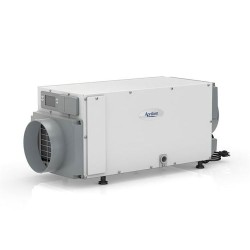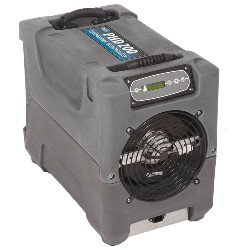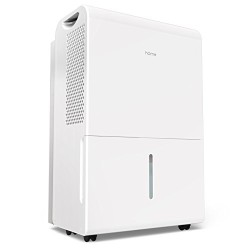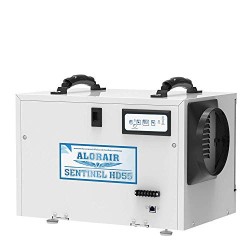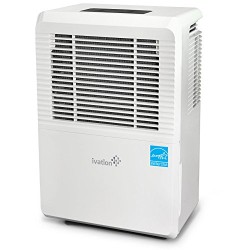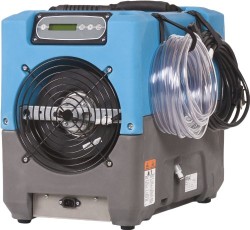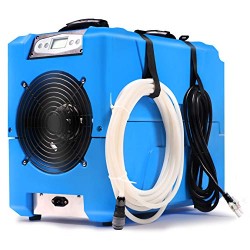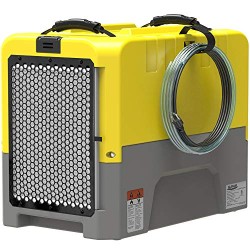We’ve spent countless hours testing and researching numerous crawl space dehumidifiers. Some of the things we looked at included the rate of dehumidification, area of coverage, and extra features such as remote control operation and a continuous drain pump. Below are what we found to be the best dehumidifiers for crawl space maintenance.
10 Best Crawl Space Dehumidifiers in 2020
AlorAir 90 PPD
The AlorAir 90 PPD removes 198 pints per day at saturation and 90 pints of water at normal humidity levels.
Saturation is considered 90% humidity, so if you have a significant problem, this may be the right choice.
It can handle temps as low as 36 degrees Fahrenheit without needing to switch off to defrost.
We found that many owners opted for this model due to the warranty.
The company offers a 1-year manufacturer warranty, 3-year coverage on the refrigeration circuit, and five years on the compressor, condenser, and evacuator.
PROS
- Hot gas valve defrosting system
- Memory setting for auto-start up
- Remote control system
- Internal corrosion protection coating
CONS
- Pump sold separately
Aprilaire 1820
The Aprilaire 1820 removes up to 70 pints of moisture per day in normal conditions.
You can use this with a flexible duct system to create a whole-home dehumidifier system or for just the crawl space.
The unit can cover an area of up to 2,800 sq ft and operates as a set and forget unit. The one downside we found with this model during testing is that it doesn’t come with a pump.
If you have a sump pump in your crawl space, you can run the dehumidifier hose into that. Otherwise, you may need to purchase a separate pump.
PROS
- Offers whole-home dehumidification
- 2,800 square foot coverage
- 5-year warranty
- Set and forget operation
CONS
- Pump not included
- No remote control operation
Dri-Eaz PHD 200
We like the compact build of the Dri-Eaz PHD 200. This system allows you to hang the unit from your crawl space beams for optimal drainage.
Unlike many of the other crawl space dehumidifiers we tested and reviewed, this model comes with a pump.
The unit can remove up to 16 gallons, or 128 pints, of moisture every day. This may be the right choice for extremely humid climates where dampness builds up fast.
The one downside we found during testing is that there is no remote control for this model.
You have to set it up from the touch-pad control system, making it difficult to change the settings in tight spaces.
PROS
- Built-in pump for efficient water removal
- Removes up to 128 pints per day
- Bright and easy to read display
- Optional hanging kit
CONS
- No remote control
HomeLabs 3000
If you need something a bit more affordable than the large commercial-grade units, the HomeLabs 3000 may be a good alternative.
This model covers up to 3,000 sq ft and can remove up to 35 pints of water per day when in continual usage mode.
If you have a severe humidity issue in your crawl space, this may not be powerful enough. The unit has a continual flow drainage port on the backside.
If you want to use this in place of the water reservoir, you will need to attach a garden hose to it. This works through gravity, so the tube will need to be lower than the unit.
PROS
- Most affordable dehumidifier reviewed
- Easy to clean dust filter
- Clears between 1,500 and 3,000 sq ft
- Turbo fan speed for more substantial moisture
CONS
- No built-in pump
- No remote interface
AlorAir 55 PPD
The AlorAir 55 comes in as one of the best and more affordable commercial level systems.
This may be a good option if you live in a high humidity climate and need a dehumidifier that can run continually.
We like that it has an optional remote display panel that can be wired into your home.
It removes up to 55 pints per day at normal levels and 120 pints in wet environments. If you live in an area that gets colder, this can be a good choice.
The unit has a hot gas valve defrosting system. This allows the system to work at low temperatures without shutting down for defrosting.
PROS
- Works in low temperatures
- Optional remote control for added convenience
- Set and forget control option
- High gas valve defrosting system
CONS
- Does not include a pump
Ivation 70 Pint
The Ivation 70 Pint is another non-commercial grade dehumidifier suitable for low humidity environments. You can cover up to 4,500 sq ft with this model.
The primary benefit is that it has a pump so you can run water vertically for more drainage options.
It doesn’t come with a remote panel, which makes adjusting the settings more difficult. One significant benefit is this is an Energy Star Certified appliance.
This means you're more likely to save on your energy bills, especially with continuous use. The unit can remove up to 70 pints every day under normal saturation conditions.
PROS
- Built-in 16watt pump
- Energy Star Certified appliance
- Covers a 4,500 square foot area
- More affordable than commercial systems
CONS
- No remote adjustment
Dri-Eaz F413
The Dri-Eaz F413 is a heavy-duty unit for taking care of areas affected by high levels of moisture.
You can remove up to 17 gallons, or 136 pints of moisture per day in heavily saturated areas.
The compact design makes this easy to use move around and provides more options for installation.
One of the things we like about this is you have plenty of options for installation. It includes a 25-foot power cord and a 40-foot drain hose.
The one downside is it doesn’t include a remote display panel, so adjustments need to be made directly through the dehumidifiers console.
PROS
- Removes up to 17 gallons per day
- Four stage high air flow filter
- Built-in auto pump
- Included 40-foot drainage hose
CONS
- No remote display option
- Not as affordable as other dehumidifiers
Mounto 80 Pints
This is a heavy use commercial grade crawl space dehumidifier. The Mounto 80 can clear up to 125 pints each day in 90% humidity environments, and 80 pints in regular rated 60% environments.
If you need a dehumidifier for substantial moisture levels, this may be a good option.
During testing and research, we found this model to be compact and easy to work with.
Many previous users noted that this unit fits easily in tight spaces and other areas where space is a limiting factor.
The one downside is, as, with several other dehumidifiers on this list, the Mounto 80 does not come with a remote interface. It is operated through a front-facing display, which may be difficult to access in tight crawl spaces.
PROS
- Compact design for easier installation
- Clears between 80 and 125 pints each day
- Includes pump for more efficient water removal
- Set and forget controls
CONS
- Lacks a clear operations manual
- Some users noted high noise levels
AlorAir Commercial
The AlorAir commercial is designed to clear out heavily saturated environments quickly.
This model is advertised for flood restorations if you're dealing with overly saturated conditions, 80% moisture, and above, this may be a good solution.
You can clear up to 190 pints each day at saturation levels. This can help to quickly eliminate excess water before mold and mildew have a chance to form.
For normal humidity levels around 60% to 70%, the rate of dehumidification is 80 pints each day. The unit comes equipped with a condensation pump for easier water removal.
PROS
- Hot gas defrost system
- Included condensation pump and hose
- Five-year warranty
- Epoxy coated corrosion-resistant coils
CONS
- Does not include remote interface control
BaseAire AirWerx
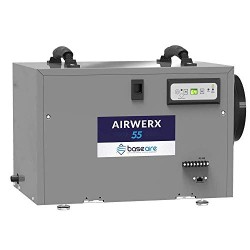
The BaseAire AirWerx is the most affordable of the high-capacity crawl space dehumidifiers we tested and reviewed. The area of coverage for the unit is up to 1,300 feet.
You can expect to clear up to 80 pints at the average 80 degrees and 60% humidity.
The AirWerx is built to be sturdy with a sheet metal housing and corrosion-resistant coils.
From our research, we found the coils to be the most common area to break down in other, non-corrosion resistant models. The one downside we found with this model is it doesn’t come with a continuous operation drain pump.
PROS
- 1,300 square foot coverage area
- Five-year warranty
- Users noted it runs quiet
- Set and forget operation
CONS
- No drainage pump
- Remote interface sold separately
Important Things to Consider
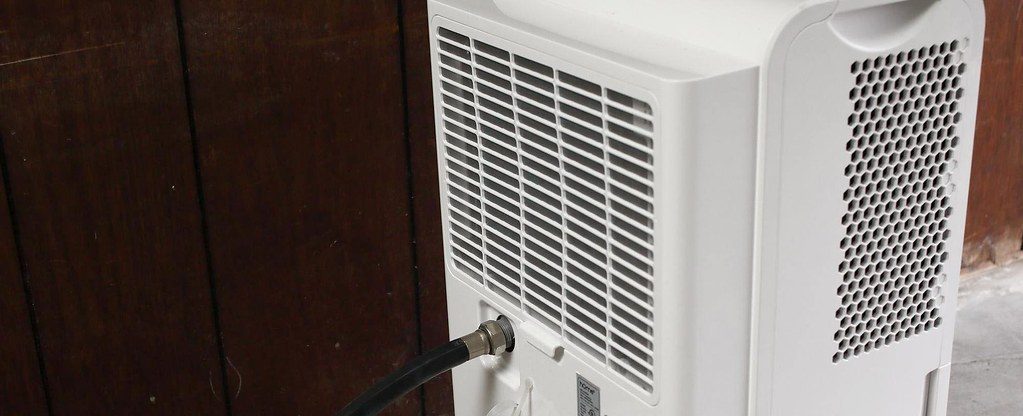
Dehumidification Rate Performance
Crawl spaces, especially in naturally humid climates, often suffer from high moisture levels. They are below the ground and generally have poor circulation allowing water to pool up. Over time, the water levels can build up and cause mold and mildew as well as wood rot.
For this reason, crawl space dehumidifiers are built to absorb moisture at a higher rate than smaller bedroom and bathroom dehumidifiers. The rate of absorption is known as the dehumidification rate and is usually measured as the number of pints a unit can absorb in a day.
When looking for the best dehumidifier for crawl space use, the higher this number the better. Especially, if there is water pooled up in your crawl space or if the wood is rotting or “sweating”.
When testing dehumidification rates, the standard setup is 80 degrees Fahrenheit with a control level of 60%. This is the standard for the American Association of Home Appliance Manufacturers (AHAM) [1]. If you see a number that says saturation rate, this is usually tested with a control level of 90%. The more saturated a room is, the more it will be able to pull out of the air during the day.
“...the indoor RH [relative humidity] was maintained below 60%... which is a common metric to quantify a system’s ability at controlling indoor humidity.”
- John Winkler, Researcher at the National Renewable Energy Laboratory [2]
Area of Coverage
The coverage area for a dehumidifier is the next most important number to look at. The dehumidify rate partially influences this number. It tells you how big of a space a humidifier can clear. This is usually measured as square feet for surface measurements or cubic feet for room volume measurements.
You want to consider this to make sure the dehumidifier you purchase isn’t too small for its intended use. If you buy a dehumidifier with a max coverage of 1,300 square feet, but your crawl space is 2,500 square feet, the unit will not be able to clear the area efficiently.
On the other hand, the amount of moisture that needs to be cleared can also affect the coverage area. A dehumidifier rated for 500 square feet that removes 40 pints each day of moisture may struggle in a 500 square foot room with 90%+ humidity. In this case, a dehumidifier may be necessary with a more powerful dehumidify rate.
“...conditions in crawl spaces are determined by the balance between moisture entering the crawlspace, moisture removed, and moisture stored in various hygroscopic materials in the crawlspace, such as wood and concrete.”
- Anton TenWolde, Researcher at the University of Wisconsin-Madison [6]
Included Water Pump
The best crawl space dehumidifier models will have a pump to help clear water. This helps push the liquid through the continuous operation drain tube to help drain the unit. Without a pump, the continuous drain feature relies on gravity to push liquids out.
This can become a problem in basements and crawl spaces as the continuous drain hose may be running vertically out a window or through the flooring. The water pump will make sure to push water through the tube, regardless of how it is situated.
Basements and crawl spaces that have a sump pump may be able to get by without the water pump by having the drain hose run directly into the sump [3].

Energy Consumption
Because your crawl space dehumidifier is likely to be running continuously throughout the day, the rate of energy consumption is essential for saving on costs. The energy rating of an appliance is usually measured in the number of watts the product uses in an hour. This is also referred to as kilowatt-hours [4].
Ideally, you want to look for dehumidifiers that have an Energy Star certification. This isn’t always possible with larger crawl space dehumidifiers and commercial grade units. But, if you need something smaller to help maintain humidity levels, a Star Certified dehumidifier will help you to save money on your energy bill [5].
Built-In Humidistat
A built-in humidistat will make your life much easier when trying to set and regulate your crawl space dehumidifier. This tool is similar to the thermostat you use for controlling heating and air conditioning in your home. The only difference here is that the thermostat measures air temperature, and a humidistat measures relative humidity levels.
An internal humidistat will give you a more accurate readout of what the relative humidity in the air is at any given time. This can help you to determine how your settings need to be adjusted.
A built-in humidistat can also help you to figure out when your dehumidifier isn’t working correctly. If you’ve got the unit set to 45% humidity and the humidistat stays at 65%, you know that the dehumidifier may need servicing.
Dehumidifier Size and Weight
Size and weight are last on the buyers guide as these two factors are probably the least important when it comes to crawl space dehumidifiers. This type of dehumidifier is one of the heaviest because it is built for high performance.
Unlike smaller bathroom dehumidifiers, a crawl space dehumidifier isn’t meant to move around frequently. You want to get it set up and then calibrate the settings and leave it.
What Size Do You Need?
The right size of the dehumidifier you need for your crawl space will depend on how bright the area is and how much moisture needs to be cleared each day. You want first to measure the surface area and volume of your crawl space to see what size dehumidifier you need.
From our research, we found many crawl space dehumidifiers had a coverage area of 4,500 sq ft at the higher end and 1,300 sq ft at the lower end. This covers a wide range of home sizes.
If you are having a severe issue, make sure to go with a larger and more powerful dehumidifier, even for a smaller size crawl space. On the other hand, if you have a smaller crawl space and just need a dehumidifier to help regulate the temperature throughout the summer months, a smaller unit will do the trick as long as the coverage area matches what you need.
FAQs
You dehumidify a crawl space using a dehumidifier specially designed to cover larger surface areas. Crawl spaces can become damp during the ordinary course of a day, especially in high humidity climates. That humidity can become trapped in the crawl space and eventually soak into the foundation.
A regular dehumidifier will work in a crawl space as long as the coverage area and rate of dehumidification are correct. If you have a significant problem under your crawl space, you will want something more than a bathroom dehumidifier designed for smaller spaces.
Make sure to calculate the surface area and volume of your crawl space. Then, find out how severe your problem is to know what rate of dehumidification you need. These two numbers will determine how large of a dehumidifier you need.
The ideal crawl space humidity level is between 30% and 60%. Ideally, the humidity level in your crawl space will level off around 50% [7]. To help maintain these humidity levels, you need to ensure that you have the best crawl space dehumidifier and that everything is hooked up and draining correctly.
Crawl space dehumidifiers are expensive because the cooling surface is larger than that of lower end dehumidifiers. This means that more moisture is removed from air at a specific time. Additionally, less expensive crawl space dehumidifiers will most likely require higher repair cost.
Crawl space dehumidifiers should be placed in areas that have abnormally high humidity. These dehumidifiers perform better when there's airflow around them, so install the dehumidifier near the center of the room, about 12 inches away from your furniture and walls.
The cost of running a large-capacity dehumidifier designed for difficult areas like crawl spaces should be around $800 to $1,200. The cost depends on various factors, including capacity, size, type, and other added features. They key here is to know what size you need to avoid unnecessary costs.
Yes. It is completely safe to leave your crawl space dehumidifier running all night. While there are no harmful effects on your health, you may need to consider other factors like unbearable noise and overflowing water. Check your dehumidifier model and see if it has enough tank capacity or lower noise output.
The Top Crawl Space Dehumidifier is...
The best crawl space dehumidifier on our list is the AlorAir 90 PPD. It is highly rated by users and performed well during experiments.
The remote control can be wired into your home, which makes adjusting the settings easier. There is also an option for a pump to effectively move water out of your crawl space.
Overall, this unit is equipped with impressive features for heavy-duty jobs and regular maintenance of humidity levels. It’s also more affordable than many of the commercial-grade units we reviewed.
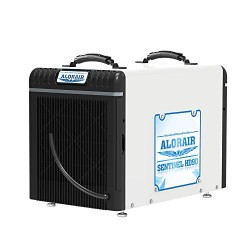
AlorAir 90 PPD
Our #1 Recommendation
- Hot gas valve defrosting system
- Memory setting for auto-start up
- Remote control system
- Internal corrosion protection coating

